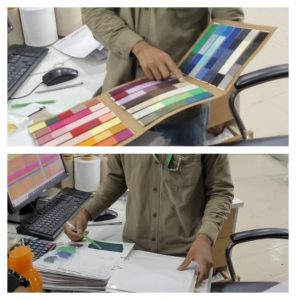Color Without Compromise in Textile-Waste Recycling: Simco’s Innovation Story
Bangladesh’s apparel sector produces vast amounts of textile and garment waste each year, presenting a unique opportunity for innovation in recycling. Traditional recycling methods, however, rely heavily on water and harmful chemicals during dyeing, causing significant environmental harm, increasing CO2 emissions, and degrading product quality. Addressing these challenges, Simco Spinning and Textile- a multinational textile-to-textile recycling company working in Bangladesh, pioneered a revolutionary process that eliminates the need for dyeing altogether. By blending pre-colored fibers to create desired shades without water or chemicals, this innovation not only ensures environmental sustainability but also preserves the integrity of recycled fibers. Simco’s groundbreaking approach marks a transformative step forward in pre-consumer garment waste recycling, positioning it as a pioneer in sustainable textile solutions.

The process involved blending pre-colored fibers in different blending ratios to achieve desired shades. Unlike traditional methods that rely on fiber dyeing to achieve desired shades, this process avoided the use of water, dyes or chemicals. In this color blending method, creating a specific shade of light lavender involves carefully combining fibers of purple, white, and pink in different blending ratios. The process allows for easy adjustments by applying it to a smaller sample; if the resulting shade is too light, more purple can be added, while more white and pink can be incorporated if the resulting shade is too dark. Once the targeted shade is achieved, the composition formula is recorded in proprietary ‘Databook’ to ensure consistency during production.
The dyeing process of imparting color using chemicals compromises the fiber quality. As a result, the yarns made from recycled fibers are often coarse, lower-quality that could only be used for cleaning materials and other home textiles. The new dyeing-free recycling process, since it reduces water and chemical usage, could avoid quality degradation by dyeing. This mechanism has a proven record of reducing environmental impact and improving product quality. Simco grew from initially producing coarse, lower-quality yarn to now offering CYCLO® recycled fibers, which are internationally recognized as a sustainable fiber for apparel and various textile applications. They provided data showing that 1 kg of CYCLO Yarn, made up of 70% Recycled Cotton and 30% Recycled Polyester, saves up to 7.5 kg (96.3%) of CO2 emissions, 2,626 liters (99.8%) of water consumption, and 7.1 kg (82.7%) of terrestrial ecotoxicity. This process also lowers production costs by eliminating the expenses related to dyeing, such as water, chemicals, and both fixed and variable overhead costs.

Several recycling factories, including Mosharaf Composite Textile Mills Ltd., have started adopting this practice. They have started investing in the color blending method and have already conducted a number of trials. They presented the concept and results (figure: Data Book) to a number of their buyers and received positive feedback. This new practice of eliminating dyes, water, and chemicals from production could serve as a benchmark in the textile industry, proving that sustainability can be achieved while maintaining quality. Although the process may require research and development expenses, the resulting cost-effective manufacturing process would allow for high profitability while ensuring sustainable production practices. This will surely encourage other companies in the ready-made garment (RMG) industry to rethink and redesign their traditional dyeing processes, contributing to the development of a more sustainable garment industry.
In summary, this innovation in pre-consumer textile waste recycling has delivered three significant benefits: (i) reducing recycling costs, (ii) fostering co-creation of garment designs between brands and suppliers, and (iii) mitigating climate change impacts within global apparel supply chains.
- Cost Reduction in Waste Recycling: The dyeing-free process eliminates expenses related to water, chemicals, and dyeing operations, significantly lowering production costs. This enables cost-efficient recycling while maintaining product quality.
- Co-Creation of Garment Designs: The innovation allows precise control over fiber blending ratios to create various shades. This flexibility fosters collaboration between brands and suppliers in developing unique designs with consistent, sustainable inputs.
- Climate Change Mitigation: By avoiding water usage, harmful chemicals, and reducing CO2 emissions, this method significantly lowers the environmental footprint. Adoption of such practices in the supply chain contributes directly to sustainability and climate goals.
This case is prepared based on the field work by CREATE Research project (20-10-AAU), Funded by DANIDA, Denmark.
Cite As: Alam, S.M.S. and Islam, S.A. (2024) ‘Color Without Compromise in Textile-Waste Recycling: Simco’s Innovation Story’, accessed on http://createproject.aust.edu/publications/, Case study, Circular Economy in Bangladesh’s Apparel Industry (CREATE) Project Publication series.